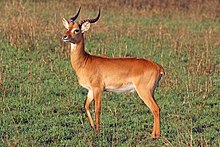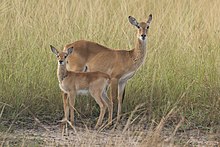KOB
| Kob | |
|---|---|
 |
|
| Male | |
 |
|
| Female and calf both K. k. thomasi Semliki Wildlife Reserve, Uganda |
|
| Scientific classification | |
| Kingdom: | Animalia |
| Phylum: | Chordata |
| Class: | Mammalia |
| Order: | Artiodactyla |
| Family: | Bovidae |
| Genus: | Kobus |
| Species: | K. kob |
| Binomial name | |
|
Kobus kob (Erxleben, 1777) |
|
| Subspecies | |
|
|
 |
|
| Geographic range | |
The kob (Kobus kob) is an antelope found across sub-Saharan Africa, in Gashaka Gumti National Park, Nigeria and some part of Senegal to South Sudan. Found along the northern savanna, it is often seen in Murchison Falls and Queen Elizabeth National Park, Uganda; Garamba and Virunga National Park, and the Democratic Republic of the Congo, as well as grassy floodplains of South Sudan. Kob are found in wet areas (such as floodplains), where they eat grasses. Kob are diurnal, but inactive during the heat of the day. They live in groups of either females and calves or just males. These groups generally range from five to 40 animals.
Among the kobs of eastern Africa, the Ugandan kob (Kobus kob thomasi) appears on the coat of arms of Uganda, and white-eared kobs (Kobus kob leucotis), found in South Sudan, southwest Ethiopia, and extreme northeast Uganda, participate in large-scale migrations.
The kob resembles the impala but is more robust. However, males are more robust than females and have horns. Males have shoulder heights of 90–100 cm (3.0–3.3 ft) and an average weight of 94 kg (207 lb). Females have shoulder heights of 82–92 cm (2.69–3.02 ft) and weigh on average 63 kg (139 lb). The pelage of the kob is typically golden to reddish-brown overall, but with the throat patch, eye ring, and inner ear being white, and the forelegs being black at the front. Males get darker as they get older. Those of the white-eared kob (K. k. leucotis), which is found in the Sudd region (the easternmost part of their range), are strikingly different and overall dark, rather similar to the male Nile lechwe, though with a white throat and no pale patch from the nape to the shoulder. Both sexes have well-developed inguinal glands that secrete a yellow, waxy substance, as well as preorbital glands.
...
Wikipedia

